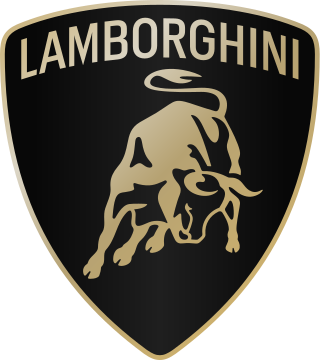
Automobili Lamborghini S.p.A. is an Italian manufacturer of luxury sports cars and SUVs based in Sant'Agata Bolognese. The company is owned by the Volkswagen Group through its subsidiary Audi.
Fiat S.p.A., or Fabbrica Italiana Automobili Torino, was an Italian holding company whose original and core activities were in the automotive industry, and that was succeeded by Fiat Chrysler Automobiles NV (FCA). The Fiat Group contained many brands such as Ferrari, Maserati, Fiat, Alfa Romeo, the Chrysler Group, and many more. On 29 January 2014, it was announced that Fiat S.p.A. was to be merged into a new Netherlands-based holding company Fiat Chrysler Automobiles NV (FCA), taking place before the end of 2014. Fiat Chrysler Automobiles became the new owner of Fiat Group. On 1 August 2014, Fiat S.p.A. received necessary shareholder approval to proceed with the merger. The merger became effective 12 October 2014.

The Ford Mustang is a series of American automobiles manufactured by Ford. In continuous production since 1964, the Mustang is currently the longest-produced Ford car nameplate. Currently in its seventh generation, it is the fifth-best selling Ford car nameplate. The namesake of the "pony car" automobile segment, the Mustang was developed as a highly styled line of sporty coupes and convertibles derived from existing model lines, initially distinguished by "long hood, short deck" proportions.

The Ford Anglia is a small family car that was designed and manufactured by Ford UK. It is related to the Ford Prefect and the later Ford Popular. The Anglia name was applied to various models between 1939 and 1967. In total, 1,594,486 Anglias were produced. It was replaced by the Ford Escort.

The Ford Torino is an automobile that was produced by Ford for the North American market between 1968 and 1976. It was a competitor in the intermediate market segment and essentially a twin to the Mercury Montego line.
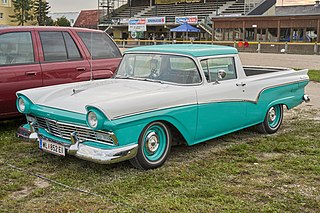
The Ford Ranchero is a coupe utility that was produced by Ford between 1957 and 1979. Unlike a standard pickup truck, the Ranchero was adapted from a two-door station wagon platform that integrated the cab and cargo bed into the body. A total of 508,355 units were produced during the model's production run. Over its lifespan it was variously derived from full-sized, compact, and intermediate automobiles sold by Ford for the North American market.
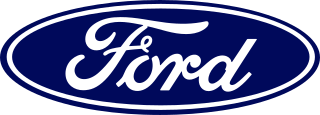
Ford Motor Company of Australia Limited is the Australian subsidiary of United States-based automaker Ford Motor Company. It was founded in Geelong, Victoria, in 1925 as an outpost of Ford Motor Company of Canada, Limited. At that time, Ford Canada was a separate company from Ford USA. Henry Ford had granted the manufacturing rights of Ford motor vehicles in the British Empire, to Canadian investors.
Economy car is a term mostly used in the United States for cars designed for low-cost purchase and operation. Typical economy cars are small, lightweight, and inexpensive to both produce and purchase. Stringent design constraints generally force economy car manufacturers to be inventive. Many innovations in automobile design were originally developed for economy cars, such as the Ford Model T and the Austin Mini.

Carrozzeria Ghia SpA is an Italian automobile design and coachbuilding firm, established by Giacinto Ghia and Gariglio as "Carrozzeria Ghia & Gariglio". The headquarters are located at Corso Guglielmo Marconi, 4, Turin. The company is currently owned by Ford Motor Company and focused on the European market through Ford's subsidiary in the region.

The Triumph Herald is a small two-door car introduced by Standard-Triumph of Coventry in 1959 and made through to 1971. The body design was by the Italian stylist Giovanni Michelotti, and the car was offered in saloon, convertible, coupé, estate and van models, with the latter marketed as the Triumph Courier.

The Ford LTD II is an automobile produced and marketed by Ford Motor Company between 1977 and 1979 in the United States and Canada. Deriving its name from the full-sized Ford LTD model line, the intermediate LTD II consolidated the Ford Torino and Gran Torino model lines, with the Ford Elite replaced by the Ford Thunderbird. Offered in a two-door sedan, four-door sedan, and station wagon, the LTD II also served as a basis for the final generation of the Ford Ranchero coupe utility.

The Ford Fairlane is an automobile model that was sold between the 1955 and 1970 model years by Ford in North America. Taking its name from the Dearborn, Michigan estate of Henry Ford, the Fairlane nameplate was used for seven different generations of vehicles. Through its production, the model line would be marketed in a wide variety of body styles, including two-door and four-door sedans, two-door and four-door hardtops, station wagons, and both traditional and retractable-hardtop convertibles.

The automotive industry in Italy is a quite large employer in the country, it had over 2,131 firms and employed almost 250,000 people in 2006. Italy's automotive industry is best known for its automobile designs and small city cars, sports and supercars. The automotive industry makes a contribution of 8.5% to Italian GDP.

Ford Motor Company Limited, trading as Ford of Britain, is a British wholly owned subsidiary of Ford Technologies Limited, itself a subsidiary of Ford International Capital LLC, which is a subsidiary of Ford Motor Company. Its business started in 1909 and has its registered office in Laindon, Essex. It adopted the name of Ford of Britain in 1960.
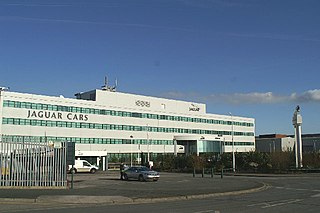
Jaguar Land Rover Halewood is a Jaguar Land Rover factory plant in Halewood, Merseyside, England, and forms the major part of the factory complex in Halewood which is shared with Ford of Britain who manufacture transmissions at the site, and who opened the site in 1962 as their Halewood Body & Assembly plant.

The Ford Falcon is a model line of cars that was produced by Ford from the 1960 to 1970 model years. Though preceded by the Rambler American, the Falcon was the first compact car marketed by the Big Three American manufacturers.
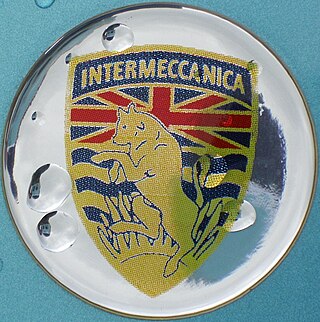
Intermeccanica is an automobile manufacturer, founded in Torino, Italy, in 1959 by Frank Reisner. It subsequently moved first to the United States, then to Canada, and is currently headed by Frank's son, Henry Reisner.

Ford of Europe GmbH is a subsidiary company of Ford Motor Company founded in 1967 in Cork, Ireland, with headquarters in Cologne, Germany.

OSI, acronym for Officine Stampaggi Industriali was a coachbuilding company founded in 1960 in Turin by former Ghia president Luigi Segre (1919–63) and Arrigo Olivetti (1889–1977) from the Fergat company, a manufacturer of automotive components. OSI was intended to be an independent design branch of Ghia's, focussing on niche efforts.

Askoll EVA S.p.A. is an Italian manufacturer of two-wheeled electric vehicles for urban mobility. The Dueville based company produces e-bikes, electric scooters, components and kits. Askoll EVA is a subsidiary of Askoll Group, an Italian corporation specialized in manufacturing electric motors and drain pumps for washing machines, heating systems and other domestic appliances.
















